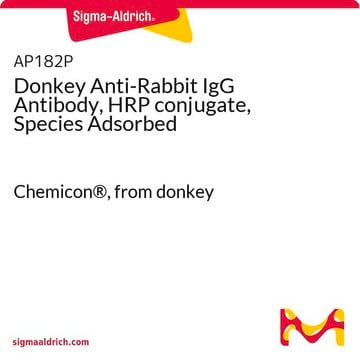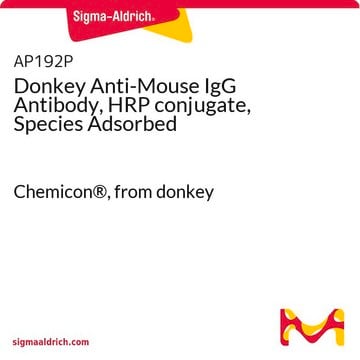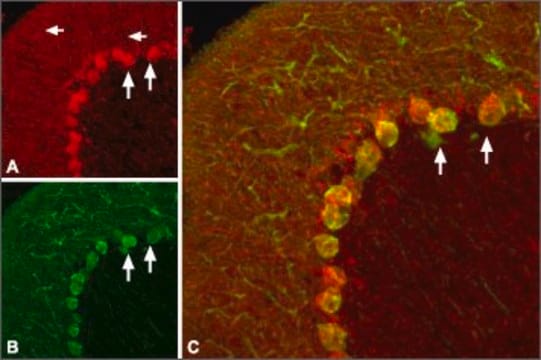推荐产品
一般說明
Anti-BDNF, mouse monoclonal, clone 35928.11, recognizes the ~20 kDa BDNF protein in brain extracts. It is validated for ELISA, Western blotting, immunohistochemistry, and neutralization studies.
Immunoaffinty purified mouse monoclonal antibody. Recognizes the ~20 kDa BDNF protein.
Recognizes the ~20 kDa BDNF protein in brain extracts. Clone 35928.11 was selected based on its ability to neutralize the biological activity of human recombinant BDNF.
免疫原
recombinant protein consisting of amino acids 129-247 of human BDNF
應用
ELISA (0.5-1 µg/ml)
Immunoblotting (1-2 µg/ml)
Immunohistochemistry (5-15 µg/ml)
Neutralization Studies (see comments)
Immunoblotting (1-2 µg/ml)
Immunohistochemistry (5-15 µg/ml)
Neutralization Studies (see comments)
警告
Toxicity: Standard Handling (A)
外觀
Lyophilized from PBS, 5% trehalose.
重構
We recommend resuspending the lyophilized antibody with sterile PBS, pH 7.4, or sterile 20 mM Tris-saline (20 mM Tris containing 0.15 M NaCl), pH 7.4, to yield a final concentration of 100 µg/ml. Following reconstitution, aliquot and freeze (-20°C).
其他說明
Riccio, A., et al. 1997. Science277 1097.
Sendtner, M., et al. 1996. Neurochem. Res.21, 831.
Barbacid, M. 1995. Ann. N.Y. Acad. Sci.766, 442.
Gotz, R., et al. 1994. Nature372, 266.
Snider, W.D. 1994. Cell77, 627.
Snider, W.D., et al. 1992. J. Neurobiol.23, 1231.
Sendtner, M., et al. 1996. Neurochem. Res.21, 831.
Barbacid, M. 1995. Ann. N.Y. Acad. Sci.766, 442.
Gotz, R., et al. 1994. Nature372, 266.
Snider, W.D. 1994. Cell77, 627.
Snider, W.D., et al. 1992. J. Neurobiol.23, 1231.
The full-length sequence for BDNF can be found under accession number NP_001700. This antibody has been selected for its ability to neutralize the biological activity of human recombinant BDNF. The exact concentration of antibody required to neutralize human recombinant BDNF activity is dependent on the cytokine concentration, cell type, growth conditions, and the type of activity studied. Suggested neutralization concentration required to yield one-half maximal inhibition of BDNF activity is approximately 5-15 µg/ml in the presence of 2.5 ng/ml of human recombinant BDNF, in a neuron survival assay using embryonic chick dorsal root ganglia neurons. The detection limit for human recombinant BDNF is ~300 ng/lane under non-reducing and reducing conditions. The detection for human recombinant BDNF is ~12.5 ng/ml. Based on immunoblotting and ELISA, this antibody exhibits less than 2% cross-reactivity with human recombinant β-NGF, human recombinant NT-3, and human recombinant NT-4. Antibody should be titrated for optimal results in individual systems.
法律資訊
CALBIOCHEM is a registered trademark of Merck KGaA, Darmstadt, Germany
Not finding the right product?
Try our 产品选型工具.
儲存類別代碼
11 - Combustible Solids
水污染物質分類(WGK)
WGK 1
閃點(°F)
Not applicable
閃點(°C)
Not applicable
A Markham et al.
The European journal of neuroscience, 20(5), 1189-1196 (2004-09-03)
Brain-derived neurotrophic factor (BDNF) governs both the selective survival of neurons during development and the experience-based regulation of synaptic strength throughout life. BDNF produced a concentration-dependent increase in the respiratory control index (RCI, a measure of the efficiency of respiratory
Natalia A Stefanova et al.
Aging, 8(11), 2713-2733 (2016-10-18)
Mitochondrial aberrations are observed in human Alzheimer's disease (AD) and in medical conditions that increase the risk of this disorder, suggesting that mitochondrial dysfunction may contribute to pathophysiology of AD. Here, using OXYS rats that simulate key characteristics of sporadic
Hugo Talbot et al.
Scientific reports, 10(1), 12572-12572 (2020-07-30)
Evading apoptosis and sustained survival signaling pathways are two central hallmarks of B-cell chronic lymphocytic leukemia (B-CLL) cells. In this regard, nurse-like cells (NLC), the monocyte-derived type 2 macrophages, deliver stimulatory signals via B-cell activating factor (BAFF), a proliferation-inducing ligand
Tinmarla F Oo et al.
Molecular and cellular neurosciences, 41(4), 440-447 (2009-05-05)
Brain-derived neurotrophic factor (BDNF) was the first purified molecule identified to directly support the development of mesencephalic dopamine neurons. However, its physiologic role has remained unknown. Based on patterns of expression, it is unlikely to serve as a target-derived neurotrophic
Milena Penkowa et al.
Journal of neuroscience research, 83(6), 974-984 (2006-02-24)
Brain injury and neuroinflammation are pathophysiologic contributors to acute and chronic neurologic disorders, which are progressive diseases not fully understood. Mammalian metallothioneins I and II (MT-I&II) have significant neuroprotective functions, but the precise mechanisms underlying these effects are still unknown.
我们的科学家团队拥有各种研究领域经验,包括生命科学、材料科学、化学合成、色谱、分析及许多其他领域.
联系技术服务部门







